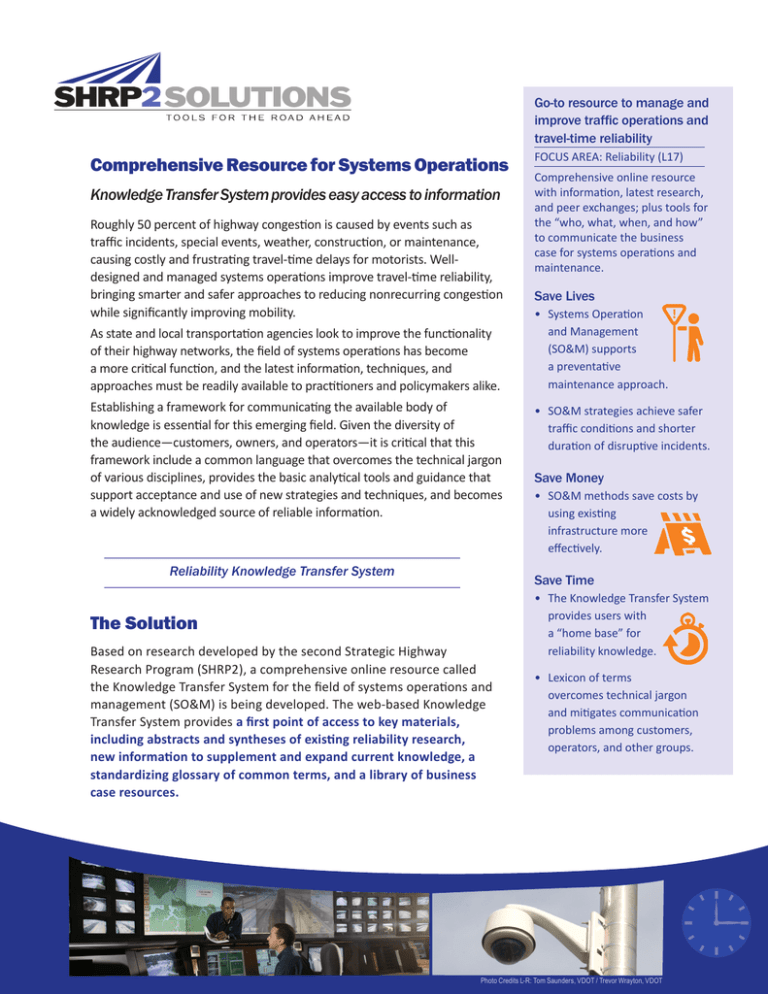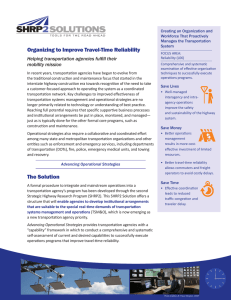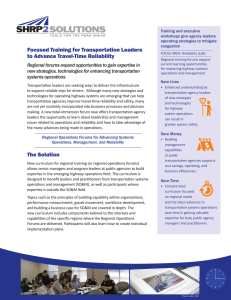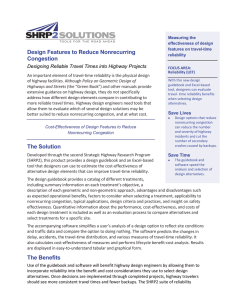Comprehensive Resource for Systems Operations Go-to resource to manage and
advertisement

Go-to resource to manage and improve traffic operations and travel-time reliability Comprehensive Resource for Systems Operations Knowledge Transfer System provides easy access to information Roughly 50 percent of highway congestion is caused by events such as traffic incidents, special events, weather, construction, or maintenance, causing costly and frustrating travel-time delays for motorists. Welldesigned and managed systems operations improve travel-time reliability, bringing smarter and safer approaches to reducing nonrecurring congestion while significantly improving mobility. As state and local transportation agencies look to improve the functionality of their highway networks, the field of systems operations has become a more critical function, and the latest information, techniques, and approaches must be readily available to practitioners and policymakers alike. Establishing a framework for communicating the available body of knowledge is essential for this emerging field. Given the diversity of the audience—customers, owners, and operators—it is critical that this framework include a common language that overcomes the technical jargon of various disciplines, provides the basic analytical tools and guidance that support acceptance and use of new strategies and techniques, and becomes a widely acknowledged source of reliable information. Reliability Knowledge Transfer System FOCUS AREA: Reliability (L17) Comprehensive online resource with information, latest research, and peer exchanges; plus tools for the “who, what, when, and how” to communicate the business case for systems operations and maintenance. Save Lives •• Systems Operation and Management (SO&M) supports a preventative maintenance approach. •• SO&M strategies achieve safer traffic conditions and shorter duration of disruptive incidents. Save Money •• SO&M methods save costs by using existing infrastructure more effectively. Save Time The Solution Based on research developed by the second Strategic Highway Research Program (SHRP2), a comprehensive online resource called the Knowledge Transfer System for the field of systems operations and management (SO&M) is being developed. The web-based Knowledge Transfer System provides a first point of access to key materials, including abstracts and syntheses of existing reliability research, new information to supplement and expand current knowledge, a standardizing glossary of common terms, and a library of business case resources. •• The Knowledge Transfer System provides users with a “home base” for reliability knowledge. •• Lexicon of terms overcomes technical jargon and mitigates communication problems among customers, operators, and other groups. Photo Credits L-R: Tom Saunders, VDOT / Trevor Wrayton, VDOT Intended for use by practitioners, researchers, and policymakers, the site functions as a portal to the complete range of SO&M information available. It also includes links to external websites and selected technical documents; background materials; an extensive section for frequently asked questions; and community-building functions such as peer dialog, news, and a calendar of events. In addition, a Business Case Premier has been developed to help identify the “who, what, when, and how” information needed to more effectively communicate the business case for traffic systems operation and management. In addition, several other tools are being been developed to advance the state of the practice, including a briefing book, deployment and budget guidance, evaluation measures, and options for integrating operations into decision making. The Benefits The Knowledge Transfer System is an easily accessible “home base” for this emerging area of practice. By collecting, developing, and supporting the exchange of knowledge across the topic, it raises the visibility of SO&M as an efficient approach to meeting travel demand. It will serve as the “go-to” resource for those who are involved in managing and improving traffic operations and travel-time reliability. SO&M strategies increase options for practitioners faced with solving the problem of growing congestion in ways more quickly implemented for immediate impact. Realizing that transportation agencies need options other than construction, SO&M efforts stress the importance of making the most effective use of existing structure before adding capacity. The Knowledge Transfer System provides a means to move SO&M strategies and the SHRP2 reliability research findings and products into mainstream practice among transportation professionals. How can you learn more? For more information, contact Darren Buck at FHWA, darren.buck@dot.gov; Gummada Murthy at AASHTO, gmurthy@aashto.org; or David Plazak at TRB, dplazak@nas.edu. About SHRP2 Implementation The second Strategic Highway Research Program is a national partnership of key transportation organizations: the Federal Highway Administration, the American Association of State Highway and Transportation Officials, and the Transportation Research Board. Together, these partners conduct research and deploy products that will help the transportation community enhance the productivity, boost the efficiency, increase the safety, and improve the reliability of the Nation’s highway system. Strategic Highway Research Program U.S. Department of Transportation | Federal Highway Administration American Association of State Highway and Transportation Officials ● Transportation Research Board TBG041112181811WDC







